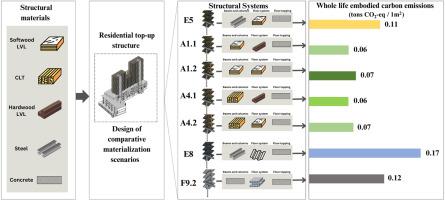Quantifying the life cycle emissions of hybrid structures with advanced bio- and conventional materialization for low-embodied carbon urban densification of the Amsterdam Metropolitan Area
IF 9.7
1区 环境科学与生态学
Q1 ENGINEERING, ENVIRONMENTAL
引用次数: 0
Abstract
More than 20% of global carbon emissions are linked with the production of construction materials used in the built environment. The use of bio-materials along with urban densification strategies that avoid demolition and reduce material demand, have been recommended to achieve urban sustainability goals. Addressing these measures, this study compares the life cycle embodied carbon emissions of seven hybrid top-up structural systems composed of concrete, steel and advanced engineered timber products made out of softwood and hardwood species. The life cycle carbon emissions (expressed in kgCO2-eq) were estimated following a cradle-to-grave approach, with a functional unit equivalent to 1 m2 of top-up structural system and focusing on The Netherlands and the city of Amsterdam as main geographical scope. A statistical analysis was included to account for the potential variation of emissions across each life cycle stage, using Monte Carlo simulations for random sampling. The results indicate that predominantly bio-based structures present a staggering 60% lower embodied carbon emissions compared with predominantly concrete, steel and modestly hybrid systems. Preserving the long-term carbon storage capacity of timber elements through high-quality reuse can offset 30–60% of the total positive emissions of the predominantly bio-based systems. Up to 6MtCO2-eq of the national carbon budget in The Netherlands can be saved from a radical uptake of bio-based structures in Amsterdam by 2050. Diversification of material diets with bio-based alternatives is recommended, along with established policy that can guarantee sustainable sourcing and prolonged lifespans through high-end reuse practices.


量化采用先进生物材料和传统材料的混合结构的生命周期排放量,实现阿姆斯特丹大都市区的低碳城市密集化
全球碳排放量的 20% 以上与建筑环境中使用的建筑材料的生产有关。为实现城市可持续发展目标,人们建议使用生物材料以及避免拆除和减少材料需求的城市密集化战略。针对这些措施,本研究比较了由混凝土、钢材和软木及硬木制成的高级工程木材产品组成的七种混合上部结构系统的生命周期内含碳排放量。生命周期碳排放量(以 kgCO2-eq 表示)的估算采用了 "从摇篮到坟墓 "的方法,功能单位相当于 1 平方米的顶部结构系统,并以荷兰和阿姆斯特丹市为主要地理范围。采用蒙特卡洛随机抽样模拟法进行了统计分析,以考虑每个生命周期阶段排放的潜在变化。结果表明,与主要采用混凝土、钢材和适度混合的系统相比,主要采用生物材料的结构的内含碳排放量要低 60%。通过高质量的再利用来保持木材构件的长期碳储存能力,可以抵消主要生物基系统总正排放量的 30-60%。到 2050 年,在阿姆斯特丹大力采用生物基结构,可节省高达 600 万吨二氧化碳当量的荷兰国家碳预算。建议使用生物基替代品实现材料饮食的多样化,同时制定政策,确保可持续采购,并通过高端再利用实践延长使用寿命。
本文章由计算机程序翻译,如有差异,请以英文原文为准。
求助全文
约1分钟内获得全文
求助全文
来源期刊

Journal of Cleaner Production
环境科学-工程:环境
CiteScore
20.40
自引率
9.00%
发文量
4720
审稿时长
111 days
期刊介绍:
The Journal of Cleaner Production is an international, transdisciplinary journal that addresses and discusses theoretical and practical Cleaner Production, Environmental, and Sustainability issues. It aims to help societies become more sustainable by focusing on the concept of 'Cleaner Production', which aims at preventing waste production and increasing efficiencies in energy, water, resources, and human capital use. The journal serves as a platform for corporations, governments, education institutions, regions, and societies to engage in discussions and research related to Cleaner Production, environmental, and sustainability practices.
 求助内容:
求助内容: 应助结果提醒方式:
应助结果提醒方式:


